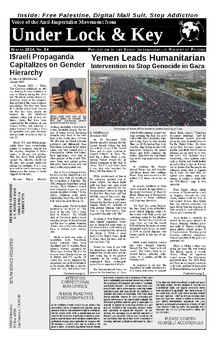
Reassessing Cell Structure 5 years out
[This is a belated resolution from the MIM(Prisons) 2010 Congress.]
Overall, MIM(Prisons) stands by the Resolutions on Cell Structure passed at the last MIM congress in 2005. After 5 years of putting that resolution into practice there is experience to sum up and questions that still need to be answered.
The theoretical basis for the cell structure is that the strength of a centralized party comes into play when vying for state power, whether by elections or otherwise. That is not in the cards for Maoists in the imperialist countries at this time. Maoism is a minority movement in the First World and will continue to be so for the foreseeable future. This makes it even more important that we utilize our strengths and shore up our weaknesses.
One of the main lessons to take from the cell structure resolutions is that "[w]e oppose having geographic cells come into contact with each other face-to-face. Infiltration and spying are rampant when it comes to MIM. The whole strength of having a locality-based cell is that it is possible to do all the things traditional to a movement. The security advantages of culling people we know into a cell are lost the moment we slack off on security and start accepting strangers or meeting with strangers face-to-face." We find it frustrating that critics of what happened at etext.org as MIM faced repression are willing to ignore the lessons of those setbacks.
At the last MIM congress in 2005, they spoke of a "MIM Center" that put out the newspaper, among other tasks. Soon after, there was no MIM Notes newspaper, followed by the degeneration of the original MC cell and finally the shutting down of their last institution, the website at etext.org.
One of the challenges of small cells is developing and maintaining line. Much work has been done, and if every new group or every revolutionary had to start from scratch, we would never advance. That is why when etext.org was repressed, MIM(Prisons) posted an archive of the MIM site on our website. While we still do not have a regular newspaper for the movement as a whole, the website is a crucial reference for us all.
Fraternal organizations do not agree on everything; they agree on cardinal principles that are determined by the conditions of the time. The etext.org site is not something Maoists must agree with 100%, but there is no doubt that it is still the most comprehensive starting point for any Maoist organization in the First World.
Democratic centralism is important for security and for political line development. Yet until we are organizing on a countrywide basis, there is no need for democratic centralism at that level, not to mention internationally.
In guerilla warfare, the cell structure has been applied in a way that was hierarchical so that action cells were separate from each other, but each cell could be traced to the top of the organization. This relies on a centralized organization or center. While MIM mentions such a center being based around MIM Notes and etext.org in their 2005 resolutions, we do not see the need for this center given the current circumstances. As we have recognized before, certain ideological centers are bound to exist based on the law of uneven development. Yet such centers are not structural, but fluid, based on the type and amount of work done.
All that said, there is an inherent contradiction in the cell strategy. Since organizing strategy and security tactics are not dividing line questions, once the cell strategy is adopted and full decentralization has occurred, it is possible for cells to change their line on this question. Even the majority could do so and a new centralized party could push remaining cells to the periphery. Since we work to build a movement and not our individual organizations, and our work is already on the periphery, we should not be concerned about the impacts of such a move on our organization. It is, however, worrisome to the extent that we see our comrades opened up to attacks through faulty security.
Part of accepting cell strategy is distinguishing between cadre work and mass work. The self-described anarchist movement is able to mobilize large numbers in mass work while abhorring centralized organization. We should learn from their example, while not succumbing to liberalism in our security practices or abandoning scientific leadership.
Getting the correct balance of cadre work and mass work will be more challenging with a cell structure. There is no way to impose a balance on the movement as a whole without a center, but we can pay attention to what is going on around us and get in where we fit in. Leading cells should not be shy to point out where the movement needs more investment of resources.
One amendment we would make to the "Resolutions on Cell Structure" is to cut the suggestion that a one-persyn cell "in many ways... has the least worries security-wise!" Certainly, one-persyn cells should maintain high standards for admitting others. However, the value of criticism/self-criticism on the level of day-to-day work is something that is stressed within Maoism, and we've benefited from in our own practice in MIM(Prisons). We still need democratic centralism with the cell structure to provide crucial discipline and accountability. The criticisms we can give and get from other cells will be limited in nature if our security is correct. And we have seen how one-persyn cells can degrade or disappear quickly.








